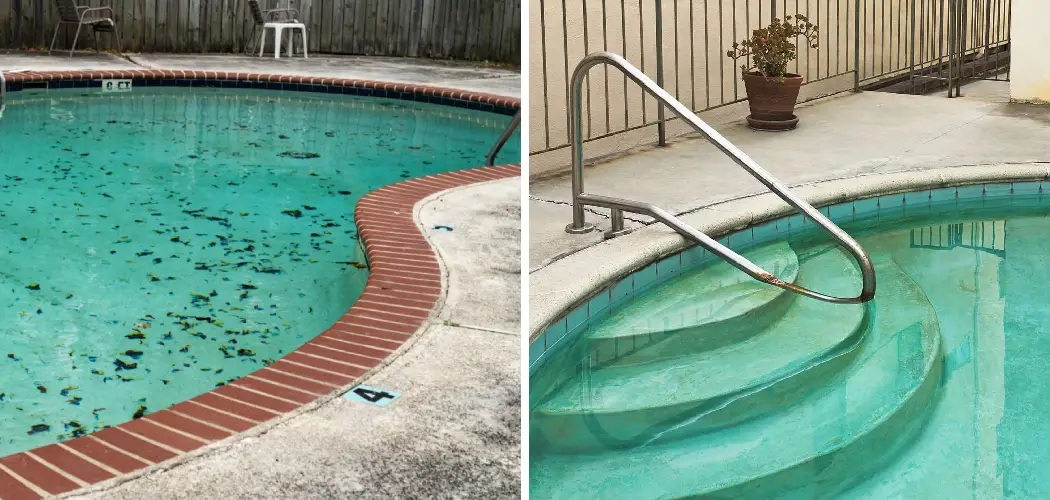Do you have pesky green algae stains in your pool that won’t disappear? You’re not alone! Algae build-up is a common and annoying problem for many pool owners, and finding effective ways to get rid of it can take time and effort. But don’t worry – today, we’ll show you the steps you need to take in order to properly tackle those unappealing algae spots so your pool can look crystal clear!
Algae stains can be a hassle to deal with, but don’t let that discourage you! With some patience and the right products, your pool will be back to its sparkling self in no time.
Read on to learn how to get algae stains out of pool.
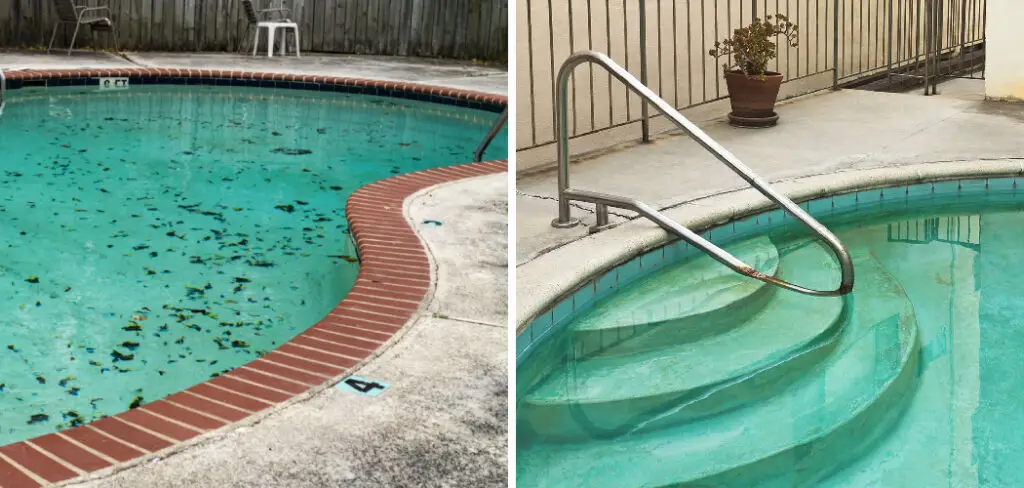
What Causes Algae Stains in Pools?
Before we dive into how to get rid of algae stains, it’s important to understand what causes them in the first place. Algae stains are typically caused by a buildup of microscopic plant life that has found its way into your pool. This can happen due to a variety of factors, including:
- Lack of proper pool maintenance and cleaning
- High levels of pH, alkalinity, or calcium hardness in the water
- Inadequate filtration or circulation in the pool
- Debris and organic matter such as leaves, dirt, and sunlight
Now that you know what can cause algae stains in your pool, let’s move on to how to get rid of them!
What Will You Need?
First things first, let’s gather the necessary tools and materials for the job. You’ll need:
- Chlorine shock treatment
- Pool brush
- Algaecide
- pH testing kit (optional but recommended)
10 Easy Steps on How to Get Algae Stains Out of Pool
Step 1. Test and Balance Your Pool Water:
Start by testing your pool’s pH, alkalinity, and calcium hardness levels using your pH testing kit. For optimal results, the pH level should be between 7.2 and 7.6. If the levels are off, use appropriate chemicals to balance them. Balanced water conditions are necessary to make your other treatments more effective.
Step 2. Brush the Pool:
Once the water is balanced, the next step is to brush the pool manually. This will break up the algae, making it easier for the chemicals to do their job. Use a pool brush to scrub the sides, bottom, and corners of your pool, paying particular attention to areas with visible algae stains. This physical removal is an essential part of how to get algae stains out of a pool.
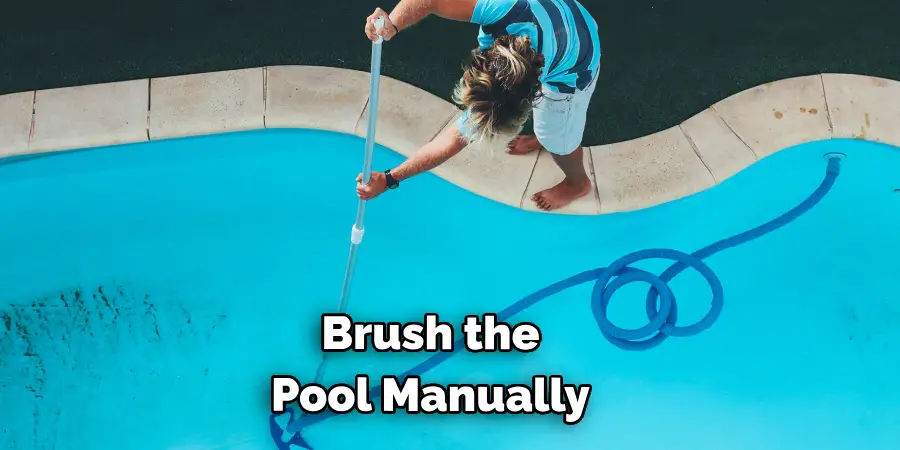
Step 3. Apply the Chlorine Shock Treatment:
The next step in removing algae stains involves applying a chlorine shock treatment to your pool. This consists in mixing the recommended amount of shock in a bucket of water (following the manufacturer’s instructions) and adding it to your pool.
The shock treatment will help to kill the algae, making it easier to remove. Let the treatment circulate in your pool for at least 8 hours (or overnight for best results). Remember, safely handling pool chemicals is crucial, so always use gloves and eye protection.
Step 4. Add Algaecide to Your Pool:
After the chlorine shock has had time to work, it’s now time to add an algaecide to your pool. This will help kill any remaining algae and prevent new growth. Follow the manufacturer’s instructions on how much algaecide to use based on the size of your pool.
Allow the algaecide to circulate in your pool for the time recommended on the product label. It is essential to give it ample time to work effectively in clearing up the algae stains.
Step 5. Brush the Pool Again:
After the algaecide has had time to work, it’s necessary to brush the pool again. This step will help to shift any leftover algae that the algaecide has killed but hasn’t managed to remove entirely.
Be thorough, and again, pay special attention to the places where you previously noticed algae stains. This second round of brushing is crucial for ensuring you get rid of all the stubborn algae stains from your pool.
Step 6. Vacuum the Pool:
After a thorough brushing session, it’s time to vacuum your pool. This step will help to remove all the dead algae and other debris that are floating in your pool water after brushing and treatment. Ensure you cover every part of the pool, and take your time to do a thorough job.
After vacuuming, allow the pool water to circulate for a few hours. Vacuuming is an essential step in getting algae stains out of your pool, as it ensures that all the dead algae are removed from the water.
Step 7. Retest and Rebalance Your Pool Water:
After the cleaning process, it’s crucial to test the water again. The shock treatment and algaecide can alter the water’s chemistry, so it’s essential to ensure the pH, alkalinity, and calcium hardness levels are still in balance. If necessary, use the right chemicals to restore the balance. Maintaining the right water balance not only helps to keep algae at bay but also ensures the water is safe for swimming.
Step 8. Regular Maintenance:
Regular maintenance is essential after you’ve cleared your pool of algae stains. This includes regular brushing, vacuuming, testing and balancing the water and using algaecide as a preventive measure.
By maintaining a regular cleaning schedule, you can prevent algae from taking hold in the first place, saving you the hassle of dealing with algae stains in the future. Regular maintenance is the final critical step on how to get algae stains out of your pool.
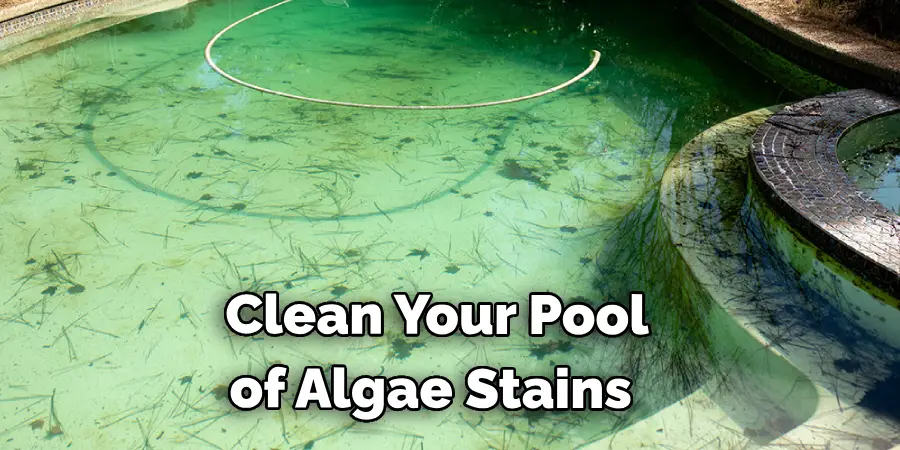
Step 9. Monitor Your Pool Regularly:
Monitoring the condition of your pool regularly is also an essential part of keeping it free from algae stains. Regular checks help to identify any changes in the water quality or condition of the pool, enabling early detection of potential algae growth.
Check for changes in water clarity, visible algae, or changes in the feel of the pool surface. If any signs of algae are noticed, repeat the steps above to tackle it promptly and prevent stain formation.
Step 10. Enjoy Your Pool:
Finally, after all your hard work and diligence in cleaning and maintaining your pool, it’s time to enjoy it! Jump in, relax, and have fun. Remember, a clean and well-maintained pool not only looks great but also provides a safe and healthy environment for you and your family to enjoy. Continue to monitor and maintain your pool, and you can prevent algae stains from becoming a problem in the first place.
By following these ten easy steps on how to get algae stains out of your pool, you can have a sparkling, clean, and inviting pool all summer long. So gather your tools and materials and get ready to enjoy the crystal-clear water in your pool!
5 Additional Tips and Tricks
- If you have a vinyl pool liner, be careful with the chlorine you use. Excessive amounts of chlorine can bleach and damage the liner, making it more susceptible to algae growth.
- Add a layer of diatomaceous earth (a type of porous rock) to your filter. This will help trap smaller particles and prevent them from getting into your pool.
- Invest in quality pool covers. Pool covers not only help keep your pool clean, but they also prevent sunlight from reaching the water, which can help reduce algae growth.
- Keep an eye on the pH levels of your pool water. Algae thrive in water with a high pH level, so test and adjust the levels regularly.
- If all else fails, consider seeking professional help from a pool maintenance company or specialist. They will have the necessary tools and knowledge to effectively remove algae stains and prevent them from returning.
With these additional tips and tricks, you should be able to keep your pool algae-free and enjoy crystal-clear water all summer long.
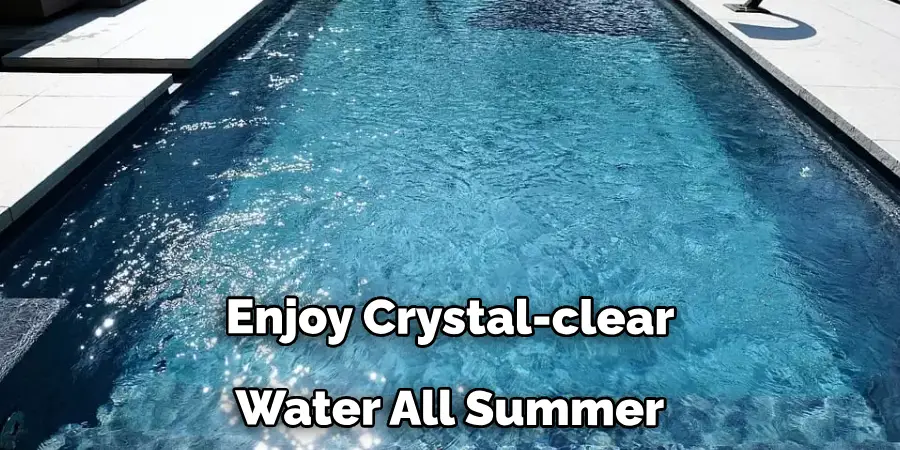
5 Things You Should Avoid
- Avoid ignoring your pool’s cleaning routine. Regular maintenance is crucial to keep algae at bay. Neglecting it can lead to the rapid growth of algae.
- Avoid overstocking your pool with chemicals. While it’s necessary to maintain certain levels of chemicals to combat algae, overdoing it can lead to other problems, such as damaging the pool’s surface or causing discomfort to swimmers.
- Avoid leaving pool covers on for an extended period. Although pool covers can reduce algae growth by blocking sunlight, leaving them on too long can create a moist, dark environment that algae love.
- Avoid allowing debris to accumulate. Leaves, grass, and other organic materials can contribute to algae growth if not removed promptly.
- Avoid ignoring signs of algae. If you notice a greenish tinge to your pool water or see patches of green on the pool walls, act immediately. Early intervention can prevent a small problem from becoming a major one.
By avoiding these common mistakes and implementing the above tips, you can effectively remove algae stains and keep your pool sparkling clean all summer. Remember to consult with a professional if you need help with how to maintain your pool correctly.
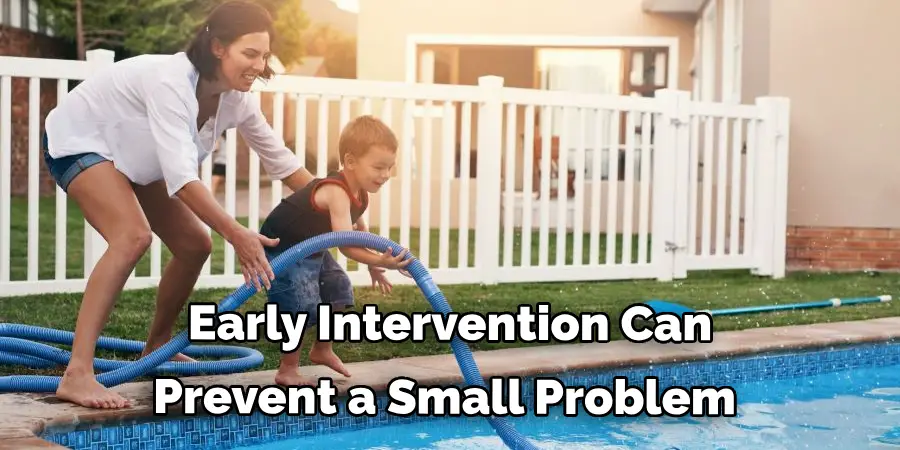
Conclusion
In conclusion, algae can be a nuisance for any pool owner. If not taken care of properly, it can quickly get out of control and take a lot of time and effort to clean up. Learning how to identify the type of algae in your pool and then taking the appropriate steps to remove it is essential to maintain sparkling clean water in your swimming pool.
Don’t let pesky algae detract from all the fun you could be having with family and friends – take action today by checking chlorine levels, brushing hard surfaces, cleaning filters, ensuring proper filtration rates, evaluating PH levels, using shock treatments and algaecides when necessary – you’ll see quick results!
Hopefully, this guide on how to get algae stains out of pool has been informative and helpful. Remember, prevention is always better than cure, so keep up with regular maintenance and monitoring of your pool to prevent algae stains from forming in the first place.
So what are you waiting for? Get out there and get those algae stains out of your pool!
About
Outdoor Fixes is a distinguished figure in the world of Diy design, with a decade of expertise creating innovative and sustainable Diy solutions.
His professional focus lies in merging traditional craftsmanship with modern manufacturing techniques,
fostering designs that are both practical and environmentally conscious. As the author of diy,
outdoorfixes delves into the art and science of outdoorfixes-making, inspiring artisans and industry professionals alike.
Education RMIT University
(Melbourne, Australia) Associate Degree in Design (Outdoor Fixes) Focus on sustainable design, industry-driven projects,
and practical craftsmanship. Gained hands-on experience with traditional and digital manufacturing tools, such as CAD and CNC software.
Nottingham Trent University
(United Kingdom) Bachelor’s in outdoorfixes.com and Product Design (Honors) Specialized in product design with a focus on blending creativity with production
techniques. Participated in industry projects, working with companies like John Lewis and Vitsoe to gain real-world insights.
Publications and Impact
In diy, Outdoor Fixes his insights on indoor design processes, materials, and strategies for efficient production.
His writing bridges the gap between artisan knowledge and modern industry needs, making it a must-read for both budding designers and seasoned professionals.

